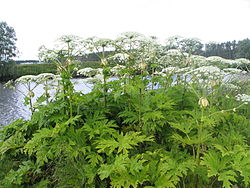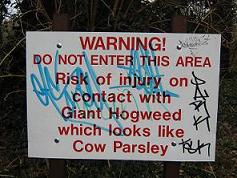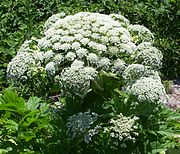
Heracleum mantegazzianum
Did you know...
SOS Children, which runs nearly 200 sos schools in the developing world, organised this selection. Child sponsorship helps children one by one http://www.sponsor-a-child.org.uk/.
| Giant Hogweed | |
|---|---|
 |
|
| Scientific classification | |
| Kingdom: | Plantae |
| Division: | Magnoliophyta |
| Class: | Magnoliopsida |
| Order: | Apiales |
| Family: | Apiaceae |
| Genus: | Heracleum |
| Species: | H. mantegazzianum |
| Binomial name | |
| Heracleum mantegazzianum Sommier & Levier |
|
Giant Hogweed (Heracleum mantegazzianum), or Giant Cow-parsley, is a member of the family Apiaceae, native to the Caucasus Region and Central Asia. It may reach 2-5 metres (rarely to 7 m) tall. Except for size, it closely resembles Common Hogweed (Heracleum sphondylium), Heracleum sosnowskyi or Garden Angelica (Angelica archangelica).
It is further distinguished by a stout, dark reddish-purple stem and spotted leaf stalks that are hollow and produce sturdy bristles. Stems vary from 3-8 cm in diameter, occasionally up to 10 cm. The stem shows a purplish-red pigmentation with raised nodules. Each purple spot on the stem surrounds a hair, and there are large, coarse white hairs at the base of the leaf stalk. The plant has deeply incised compound leaves which grow up to 1-1.7 m in width.
Giant Hogweed is a perennial with tuberous rootstalks which form perennating buds each year. It flowers from late spring to mid summer, with numerous white flowers clustered in an umbrella-shaped head that is up to 80 cm (2.5 ft) in diameter across its flat top. The plant produces flattened, 1 cm long, oval dry seeds that have a broadly rounded base, and broad marginal ridges. It flowers from late spring to mid summer, and then produces between 1,500 to 100,000 seeds. Shoots die down in the fall. Tall stems mark its locations during winter.
Many foreign plants were introduced to Britain in the 19th century, mainly for ornamental reasons. A few have become aggressively dominant, creating serious problems in some areas. It is now widespread throughout the British Isles especially along riverbanks. By forming dense stands they can displace native plants and reduce wildlife interests. It has also spread in the northeastern and northwestern United States. It is equally a pernicious invasive species in Germany, France and Belgium, overtaking the local species. It was introduced in France in the 19th century by botanists, much appreciated by beekeepers.
Phototoxicity
Giant Hogweed is a phototoxic plant. Its sap can cause phytophotodermatitis (severe skin inflammations) when the skin is exposed to sunlight or to UV-rays. Initially the skin colours red and starts itching. Then blisters form as in burns within 48 hours. They form black or purplish scars, which can last several years. Hospitalisation may become necessary. Presence of minute amounts of sap in the eyes, can lead to temporary or even permanent blindness. These reactions are caused by the presence of linear derivatives of furocoumarin in its leaves, roots, stems, flowers, and seeds. These chemicals can get into the nucleus of the epithelial cells, forming a bond with the DNA, causing the cells to die. The brown colour is caused by the production of melanin by furocoumarins. In Germany, where this plant has become a real nuisance, there were about 16,000 victims in 2003.
Children should be kept away from Giant Hogweed, and protective clothing (including eye protection) should be worn when handling it or digging it. If skin is exposed, the affected area should be washed thoroughly with soap and water and the exposed skin protected from the sun for several days.
Countermeasures
Because of its phototoxicity and its invasive nature, Giant Hogweed is often actively removed. In the UK the Wildlife and Countryside Act 1981 makes it an offence to plant or cause Giant Hogweed to grow in the wild.
For effective control, the plant should not be mowed down, but rather sprayed with an herbicide on intervals until it is gone. Even after the parent plant is completely removed, the numerous seeds left behind can germinate 7 to 15 years later, and ongoing monitoring is required. If the physical method of control uses effective bodily protection such as head to toe covering, plus eye protection, removing the green growth helps to exhaust the root and will weaken the plant, so digging it out (as far as 60 cm deep) and chopping it is feasible.

Herbicides such as 2,4-D, TBA, MCPA and dicamba will kill above ground parts but are reportedly not particularly effective on persistent rootstalks. Glyphosate ( Roundup) is considered the most effective herbicide and should be used cautiously around desirable species since it is nonselective. Application during bud stage and while the plant is actively growing is recommended by New York Cooperative Extension.


